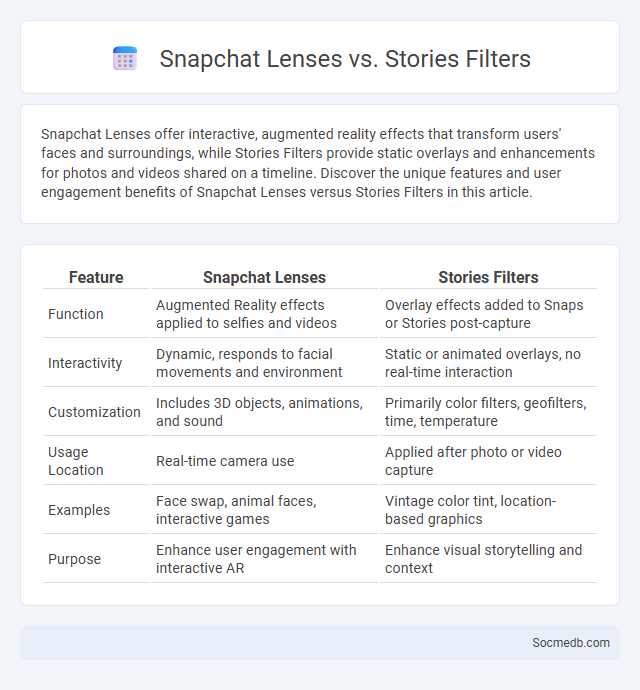
Photo illustration: Snapchat Lenses vs Stories Filters
Snapchat Lenses offer interactive, augmented reality effects that transform users' faces and surroundings, while Stories Filters provide static overlays and enhancements for photos and videos shared on a timeline. Discover the unique features and user engagement benefits of Snapchat Lenses versus Stories Filters in this article.
Table of Comparison
| Feature | Snapchat Lenses | Stories Filters |
|---|---|---|
| Function | Augmented Reality effects applied to selfies and videos | Overlay effects added to Snaps or Stories post-capture |
| Interactivity | Dynamic, responds to facial movements and environment | Static or animated overlays, no real-time interaction |
| Customization | Includes 3D objects, animations, and sound | Primarily color filters, geofilters, time, temperature |
| Usage Location | Real-time camera use | Applied after photo or video capture |
| Examples | Face swap, animal faces, interactive games | Vintage color tint, location-based graphics |
| Purpose | Enhance user engagement with interactive AR | Enhance visual storytelling and context |
Introduction to Snapchat’s Creative Tools
Snapchat's creative tools offer a dynamic platform for content creators to design engaging multimedia experiences through features like AR lenses, Bitmojis, and customizable filters. These tools leverage augmented reality technology and user-friendly interfaces to enhance storytelling and visual communication. Businesses and influencers use Snapchat's suite to drive audience interaction and brand visibility with tailored, immersive content.
What Are Snapchat Lenses?
Snapchat Lenses are augmented reality (AR) filters that transform your selfies or surroundings with dynamic effects and animations. These interactive lenses use facial recognition technology to overlay virtual elements like masks, makeup, or 3D objects onto your photos and videos. You can explore countless creative options within the Snapchat app to enhance your social media content and engage your audience.
Exploring Snapchat Stories Filters
Snapchat Stories filters offer users dynamic ways to enhance visual storytelling through augmented reality effects and interactive lenses. These filters leverage real-time facial recognition and location-based technology to personalize content, increasing engagement and user interaction. Brands utilize Snapchat's diverse filter options to create immersive marketing campaigns that resonate with younger demographics.
Lenses vs Stories Filters: Key Differences
Lenses and Stories Filters differ primarily in their interactivity and use case on social media platforms. Lenses offer real-time augmented reality effects that users can manipulate actively during video creation, while Stories Filters typically apply static or animated visual overlays to photos or videos after capture. Understanding these distinctions enhances content engagement strategies and maximizes audience appeal on platforms like Snapchat and Instagram.
How Snapchat Lenses Work
Snapchat Lenses use augmented reality (AR) technology to enhance your selfies and surroundings by overlaying 3D animations and effects in real-time. The app employs facial recognition software and depth mapping to accurately track your facial expressions and movements, ensuring the lenses adapt seamlessly to your features. This dynamic interaction creates immersive and personalized visual experiences that engage users effortlessly.
The Purpose of Stories Filters
Stories filters enhance user engagement by enabling creative self-expression and personalized content sharing on social media platforms. These filters increase interaction rates and time spent on stories, boosting visibility and audience reach for Your posts. By adding visual effects and augmented reality elements, they create immersive experiences that drive platform loyalty and content virality.
Creating Custom Lenses on Snapchat
Creating custom lenses on Snapchat allows you to design unique augmented reality experiences that engage your audience effectively. You can use Snapchat's Lens Studio, a powerful free tool, to build interactive, branded filters tailored to your marketing goals. Leveraging these custom lenses increases your social media visibility and enhances user interaction on your Snapchat profile.
Personalization With Stories Filters
Personalization with stories filters enhances your social media experience by allowing you to customize content that resonates with your unique style and preferences. These interactive filters use augmented reality and AI technology to create engaging visual effects, making your stories more attractive and memorable. Leveraging personalized filters increases audience interaction and boosts the visibility of your social media profile.
User Engagement: Lenses vs Stories Filters
User Engagement on social media platforms significantly differs between Lenses and Stories Filters. Lenses offer interactive augmented reality experiences that encourage users to actively participate and share real-time effects, leading to higher engagement rates. Your content gains more visibility and user interaction when leveraging the immersive and dynamic nature of Lenses compared to the more passive consumption of Stories Filters.
Choosing the Right Snapchat Feature for You
Choosing the right Snapchat feature enhances your social media experience by aligning with your communication style and goals. Whether you prefer Stories for sharing daily moments, Snap Map for location-based interactions, or AR Lenses for creative expression, identifying your primary purpose helps optimize engagement. Tailoring Your use of Snapchat features ensures meaningful connections and maximizes the platform's dynamic capabilities.
 socmedb.com
socmedb.com